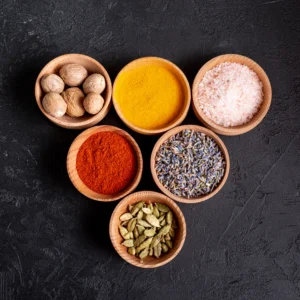Food without spices is odorless, colorless, and tasteless; spices add life to food. Given the importance of spice in human being’s food habit, it has a deep historical root with almost all the major cultures of the world, particularly the Indian culture. Spices are, in my opinion, a sign of civilization because only a savage can live without them.

- Quality: Spices in India have always been of high quality. Even in the present time, the traders try to make the Indian spices at its best by complying with international food safety standards, such as, American Spice Trade Association and European Spice Association.
- Substance: Materially speaking, oleoresins are substance responsible for providing taste to spices. Oleoresins are a mixture of essential oils and raisins and deeply impact the way a substance tastes. Oleoresins are not the sole creator of taste in spices India; aroma also plays a great role in enhancing the taste of it. This combination is not surprising since the harmonic function olfactory and gustatory receptors are well-known.
- Transformational Process: The way Indian spices would end up tasting, would depend a lot upon the maker. While cooking spices of India, a lot depends upon the order of spices added, cooking time, and other ingredients. Indian spices surely taste good; however the maker of the food should possess the quality to make them good.
- Non overlapping flavors: Recently data scientists have observed that western cultures tend to add overlapping flavors in their dishes. On the other hand, Indians use their flavors in a completely opposite way. In spices India dishes, many non-overlapping flavors are added over with each other and this eventually accentuates the taste of Indian food.
- Traditional aspect: The recipes using Indian spices have been perfected over generations. This perfection is what gives the dishes using Indian spices a unique taste.
Regional Variations Add to the Flavor Story
Each region in India uses spices differently, creating a wide variety of flavors:
- North India – Aromatic garam masala, kasuri methi, and cardamom in rich gravies.
- South India – Curry leaves, mustard seeds, and black pepper for a tangy-spicy punch.
- East India – Panch phoron (five-spice blend) and mustard oil for bold flavors.
- West India – Goda masala, asafoetida, and fiery red chilies for depth and heat.
Pairing Spices for Maximum Impact
Some spices taste even better when paired together:
- Cumin + Coriander – Earthy and balanced.
- Cinnamon + Cloves + Cardamom – Warm and festive.
- Mustard Seeds + Curry Leaves – Bright and aromatic for South Indian dishes.
FAQ
- Why do Indian spices make food taste so unique?
Indian spices are rich in essential oils and natural compounds that release complex flavors when cooked. The combination of multiple spices in precise proportions creates a layered taste that’s hard to replicate. - Do Indian spices only add flavor, or do they have health benefits too?
Apart from enhancing taste, many Indian spices have proven health benefits—turmeric supports immunity, cumin aids digestion, and cinnamon helps regulate blood sugar. - How are Indian spices different from spices used in other cuisines?
Indian cooking often uses spices in combinations and cooking techniques like tempering, roasting, or grinding fresh, which intensifies both aroma and flavor compared to simply sprinkling them in. - Can I still enjoy Indian spices if I don’t like very spicy food?
Yes. Not all Indian spices add heat—many, like cardamom, cinnamon, and fennel, add sweetness and aroma without making food hot. The spice level can be adjusted to taste. - What’s the best way to preserve the flavor of Indian spices?
Store spices in airtight containers, away from light and moisture. Whole spices last longer than ground ones, and roasting them lightly before use can revive their aroma.


